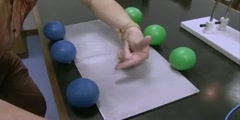Lec 35 - Physics 111: Hall Effect In A Semiconductor
Physics 111: Hall Effect In A Semiconductor Physics 111 Advanced Laboratory. Professor Sumner Davis This video accompanies the Hall Effect in a Semiconductor Experiment, providing students with an introduction to the theory, apparatus, and procedures. The Hall effect is the phenomenon of a voltage developing across two boundaries in a direction transverse to the current flow in a system of charged particles in a magnetic field owing to the Lorentz force q(v x B). Semiconductors fall in between two extremes, conductors and non-conductors, and their properties require some knowledge of condensed matter physics. The Hall Effect illustrates the Lorentz force v X B. For a doped germanium crystal, you measure the resistivity, concentration of the free carrier, and the Hall coefficient as functions of the temperature. When a current is passed through a sample in the x-direction, the Lorentz force acting on the electric charges moving in a magnetic field B ( in Z) displaces some carriers in the y-direction and causes an internal electric field EH which cancels the Lorentz force in the equilibrium case. You will use the Van der Pauw method of measuring a sample of arbitrary shape for a temperature range from 300K to 77K to 400K. http://advancedlab.org
Video is embedded from external source so embedding is not available.
Video is embedded from external source so download is not available.
Channels: Physics (General)
Tags: Physics 111: Hall Effect In A Semiconductor
Uploaded by: berkeleyphy111 ( Send Message ) on 19-09-2012.
Duration: 60m 57s
Here is the next lecture for this course
Lec 10 - Physics 111: Hall Effect In A Pl ...
12:58 | 4793 viewsWhat is Hall Effect?
06:13 | 7317 viewsLec 2 - Physics 111: Atomic Physics (ATM) ...
32:01 | 6420 viewsLec 13 - Physics 111: Josephson Junction ...
19:03 | 5190 viewsLec 8 - Physics 111: Compton Scattering (COM)
20:27 | 4609 viewsLec 24 - 8.01 Physics I: Classical Mecha ...
50:08 | 2328 viewsLec Last- 8.01 Physics I: For the Love of ...
01:01:26 | 3664 viewsLec 5 - Physics 111: Instrumentation Sect ...
27:15 | 5091 viewsLec 9 - Physics 111: Gamma Ray Spectrosco ...
27:59 | 4533 viewsLec 16 - Physics 111: Atomic Physics (ATM ...
37:43 | 4030 viewsLec 24 - Physics 111: Non-Linear Spectros ...
01:01:25 | 5371 viewsLec 25 - Physics 111: Non-Linear Spectros ...
34:46 | 4699 viewsLec 29 - Physics 111: Nuclear Magnetic Re ...
18:22 | 6430 viewsLec 30 - Physics 111: Nuclear Magnetic Re ...
21:38 | 5789 viewsLec 24 - TEDxCaltech - Charlie Marcus - N ...
11:55 | 9673 viewsNo content is added to this lecture.
This video is a part of a lecture series from of berkeley
Lecture list for this course
Lec 1 - Physics 111: Atomic Physics (ATM) Part 1. Balmer Series
Lec 2 - Physics 111: Atomic Physics (ATM) Part 2. Zeeman Effect
Lec 3 - Physics 111: Beta Ray Spectroscopy (BRA)
Lec 4 - Physics 111: Brownian Motion in Cells (BMC)
Lec 5 - Physics 111: Instrumentation Section Lab Equipment (BSC)
Lec 6 - Physics 111: Bubble Chamber (BBC)
Lec 7 - Physics 111: Carbon Dioxide Laser (CO2)
Lec 8 - Physics 111: Compton Scattering (COM)
Lec 9 - Physics 111: Gamma Ray Spectroscopy (GMA)
Lec 10 - Physics 111: Hall Effect In A Plasma (HAL)
Lec 11 - Physics 111: Holography (HOL)
Lec 12 - Physics 111: Introduction to Error Analysis
Lec 13 - Physics 111: Josephson Junction Effect (JOS)
Lec 14 - Physics 111: Radiation and Laboratory Safety
Lec 15 - Physics 111: Laser Safety
Lec 16 - Physics 111: Atomic Physics (ATM) Theory Lecture ONLY
Lec 17 - Physics 111: Energy Levels Lecture Part 1
Lec 18 - Physics 111: Energy Levels Lecture Part 2
Lec 19 - Physics 111 Light Sources and Detectors Lecture
Lec 20 - Physics 111: Optical Instruments Lecture
Lec 21 - Physics 111: Energy Transitions Lecture Series
Lec 22 - Physics 111: Laser Induced Fluorescence and Raman Scattering (LIF)
Lec 23 - Physics 111: Low Light Signal Measurements (LLS)
Lec 24 - Physics 111: Non-Linear Spectroscopy and Magneto-Optics Part 1 (MNO)
Lec 25 - Physics 111: Non-Linear Spectroscopy and Magneto-Optics Part 2 (MNO)
Lec 26 - Physics 111: Atom Trapping (MOT)
Lec 27 - Physics 111: Muon Lifetime (MUO)
Lec 28 - Physics 111: Non-Linear Dynamics and Chaos (NLD)
Lec 29 - Physics 111: Nuclear Magnetic Resonance (NMR) Part-1 Continuous Wave
Lec 30 - Physics 111: Nuclear Magnetic Resonance Part-2 Pulsed NMR
Lec 31 - Physics 111: Optical Pumping (OPT)
Lec 32 - Physics 111: How to do an Oral Report
Lec 33 - Physics 111: Optical Trapping (OTZ)
Lec 34 - Physics 111: Rutherford Scattering (RUT)
















